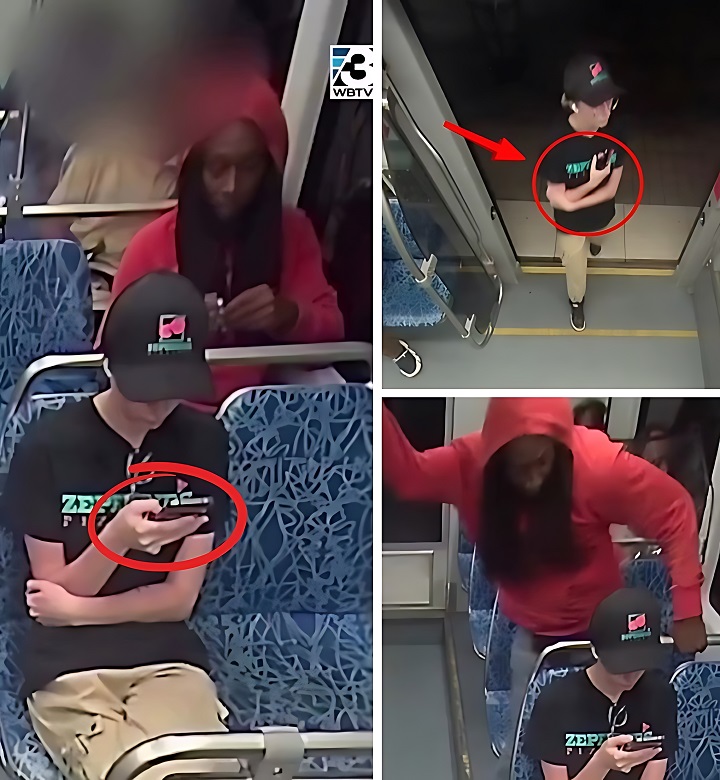In a horrifying incident that has shocked the nation and ignited debates on mental health, criminal justice, and public safety, 23-year-old Ukrainian refugee Iryna Zarutska was fatally stabbed on a Charlotte, North Carolina, light rail train. The attack, captured on surveillance video, appeared random and unprovoked at first glance. However, revelations from the suspect, Decarlos Brown Jr., have shed light on a twisted motive rooted in paranoia and delusion. According to statements made by Brown, it was an item Zarutska was carrying—her cell phone—that triggered his deadly actions.
He believed she was using it to read his mind, part of a larger conspiracy involving government-implanted materials in his body. This case not only highlights the vulnerabilities of refugees but also exposes systemic failures in addressing mental illness and repeat offenders. As details emerge, the story of Zarutska’s short life in America and her senseless death continues to unfold, prompting calls for reform and justice.
Iryna Zarutska: A Young Woman Chasing the American Dream
Iryna Zarutska was born in Ukraine amid the turmoil of ongoing conflict with Russia. Fleeing the war that ravaged her homeland, she arrived in the United States as a refugee, seeking safety and a fresh start. At just 23 years old, Zarutska had already shown remarkable resilience. She settled in Charlotte, North Carolina, a city known for its growing immigrant community and opportunities. Friends and family described her as vibrant, kind, and full of ambition. She worked diligently to build a new life, learning English, finding employment, and forming relationships that gave her hope for the future.

Her boyfriend, Stas Nikulytsia, spoke of her with deep affection, recalling her infectious smile and determination. The couple had plans—simple dreams of stability and happiness away from the horrors of war. Zarutska’s journey to America was emblematic of many refugees: a escape from violence, only to encounter unforeseen dangers in what was supposed to be a safe haven. Tragically, on August 22, 2025, her life was cut short in a brutal attack that no one could have anticipated.
On that fateful day, Zarutska boarded the Lynx Blue Line light rail train in Charlotte’s South End, heading home after a day out. Surveillance footage shows her sitting quietly, scrolling on her phone with earbuds in, oblivious to the danger approaching. This mundane act—using her phone—would later be cited by her killer as the catalyst for his rage. The train, a symbol of everyday public transportation, became the scene of a nightmare.
The Attack: A Gruesome Act Captured on Camera
The stabbing occurred suddenly and without warning. Decarlos Brown Jr., a 34-year-old man with a lengthy criminal history, approached Zarutska on the crowded train. Video evidence reveals him pulling out a knife and stabbing her multiple times in the neck and upper body. Passengers scattered in panic as Zarutska collapsed, bleeding profusely. Despite attempts by bystanders to intervene and calls for help, she succumbed to her injuries shortly after.
The footage, which has since circulated widely, is graphic and disturbing, showing the final moments of Zarutska’s life. One audio clip from the surveillance includes a voice saying, “got that white girl,” hinting at a possible racial dimension to the attack, though it’s unclear if Brown uttered the words. Zarutska, the only white passenger visible in the video, was targeted in what authorities initially described as a random act of violence. However, Brown’s subsequent statements revealed a more personal, albeit delusional, motive.
Brown fled the scene but was apprehended shortly afterward by Charlotte-Mecklenburg Police. He was charged with first-degree murder at the state level, and later, the U.S. Department of Justice added federal charges for committing an act causing death on a mass transportation system. The federal involvement underscores the severity of the crime and its implications for public safety on transit systems.
Decarlos Brown Jr.: A Troubled History of Crime and Mental Illness
Decarlos Brown Jr.’s background paints a picture of a man plagued by repeated run-ins with the law and untreated mental health issues. With at least 14 prior arrests in North Carolina, his record includes charges for assault, firearms possession, drug offenses, and more. Notably, he was released on cashless bail just months before the murder, despite his extensive rap sheet. Critics argue this reflects “soft-on-crime” policies that prioritize reform over public safety, allowing dangerous individuals to roam free.
Brown’s mental health struggles are well-documented. Diagnosed with schizophrenia, he exhibited paranoid delusions for years. Family members, including his sister Tracey Brown, described how his condition deteriorated after his release from prison in 2022. He became increasingly isolated, aggressive, and convinced that the government had implanted a microchip or “materials” in his body to control him. In January 2025, he was arrested for misusing the 911 system after repeatedly calling to report that a “man-made material” was affecting his ability to eat, walk, and speak. Police noted his erratic behavior, and a judge ordered a competency evaluation, but it was never completed.
Tracey Brown made multiple attempts to get her brother psychiatric help, visiting hospitals and pleading for admission. However, he was often discharged after brief observations, deemed not an immediate threat. “He was mentally ill,” Tracey said. “That’s all I can say, he’s mentally ill.” His paranoia escalated, leading him to believe others were part of a conspiracy against him. This untreated psychosis culminated in the attack on Zarutska.
The Provocative Item: A Cell Phone and a Paranoid Delusion
In a chilling phone call recorded by his sister on August 28, 2025—just six days after the murder—Brown revealed what prompted him to target Zarutska. Speaking from jail, he rambled about “materials” in his body that “lashed out” on her. “They just lashed out on her, that’s what happened,” he said. “Whoever was working the materials they lashed out on her. That’s all there is to it.”
But the most startling detail emerged during a face-to-face jail visit: Brown confessed he believed Zarutska was reading his mind. Surveillance footage showed her innocently scrolling on her cell phone, a common sight on public transit. To Brown, however, this was evidence of her involvement in his imagined conspiracy. He interpreted her phone use as a means to access his thoughts, perhaps through the supposed microchip in his brain. This delusion transformed an ordinary item—a smartphone—into a perceived threat, sparking his violent outburst.
“I hurt my hand, stabbing her. I don’t even know the lady. I never said not one word to the lady at all. That’s scary, ain’t it. Why would somebody stab somebody for no reason?” Brown mused in the call, seemingly aware of the irrationality yet trapped in his psychosis. The phone, an item Zarutska carried like millions do daily, became the focal point of his paranoia. It wasn’t just any object; in his mind, it was a tool for surveillance and control, linking her to the forces he feared.
This revelation shifts the narrative from a purely random attack to one driven by severe mental illness. It raises questions about how everyday technology can be misinterpreted by those suffering from delusions, turning benign actions into perceived aggressions.
Legal Proceedings and Calls for Justice
Brown now faces life imprisonment or the death penalty under federal charges. A competency evaluation has been ordered to determine if he is fit to stand trial, given his mental health history. Prosecutors, including U.S. Attorney Russ Ferguson and Attorney General Pam Bondi, have condemned the attack as an assault on the American way of life. Bondi stated, “Iryna Zarutska was a young woman living the American dream—her horrific murder is a direct result of failed soft-on-crime policies.”
Former President Donald Trump weighed in, calling Brown a “deranged monster” and demanding the death penalty. The case has become a flashpoint in political debates, with conservatives criticizing bail reform and liberals advocating for better mental health resources. Mecklenburg County District Attorney Spencer Merriweather highlighted systemic failures, noting insufficient funding for mental health care that allows individuals like Brown to cycle through the justice system without proper treatment.
Public Reaction and Broader Implications
The murder has sparked widespread outrage, particularly within Ukrainian communities in the U.S. Vigils have been held in Charlotte and beyond, honoring Zarutska’s memory and calling for safer public spaces. Her boyfriend, Stas Nikulytsia, expressed heartbreak and fury at the judge who released Brown on bail, questioning how such a repeat offender was free. “She came here to escape war, only to die like this,” he said.
The incident has reignited discussions on refugee safety, mental health reform, and criminal justice. Advocates argue for mandatory evaluations and longer holds for those showing signs of severe psychosis. Others point to the need for stricter bail conditions for violent offenders. The racial undertones, suggested by the audio clip, add another layer, prompting examinations of hate crimes in public spaces.
Zarutska’s story is a tragic reminder of the fragility of life for immigrants. Fleeing one form of violence, she encountered another in a place meant to offer refuge. As the case proceeds, many hope it will lead to changes preventing similar tragedies.
A Call for Change Amid Grief
The murder of Iryna Zarutska is more than a crime story; it’s a confluence of societal issues—mental illness, judicial shortcomings, and the challenges faced by refugees. The item that provoked her killer, a simple cell phone, symbolizes how delusions can distort reality, turning innocence into perceived threat. As investigations continue and the trial looms, the focus remains on justice for Zarutska and reforms to protect others.
Her legacy, though brief, inspires calls for compassion and action. In a world where technology connects us, it’s ironic that a phone became the spark for such devastation. Society must address these gaps to ensure no one else falls victim to unchecked paranoia and systemic neglect.



